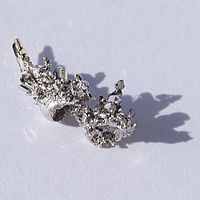
Photo from wikipedia
Abstract The efficient recovery of precious metals (PMs) from aqueous solution or wastewater is a hot issue from both economic and environmental perspectives. In the past few years, nanomaterials have… Click to show full abstract
Abstract The efficient recovery of precious metals (PMs) from aqueous solution or wastewater is a hot issue from both economic and environmental perspectives. In the past few years, nanomaterials have been applied in the capture and isolation of PM ions due to their unique physical and chemical properties, including large surface area (up to ∼ 14,600 m2‧g−1), high reactivity, and developed porosity. Hereby, we systematically review the progress and advances in the field of PM adsorption by nanomaterials such as metal oxide/sulfide nanoparticles, graphene, silica gel, nanocellulose, chitosan-support nanomaterials, and metal–organic frameworks (MOFs) etc. In this review, nano adsorbents are categorized as inorganic nanomaterials, organic polymer-support nano composites, and MOFs. The reported maximum adsorption capacity of Au (III) was 4262.8 mg‧g−1 by TU*ZIF-8, which exhibited great superiority to other nano adsorbents. Mechanisms associated with PM adsorption by nano adsorbents including physical adsorption (i.e. electrostatic interaction, diffusion) and chemical adsorption (i.e. coordination, chemical bonding, ion exchange, acid-base interaction, and reduction) are comprehensively summarized and discussed. Normally, the adsorption of PMs by nanomaterials is a complicated process involving more than one mechanism. In the future, more efforts are still needed to promote the large-scale and industrial-scale application of nano adsorbents in PM recycling.
Journal Title: Coordination Chemistry Reviews
Year Published: 2021
Link to full text (if available)
Share on Social Media: Sign Up to like & get
recommendations!